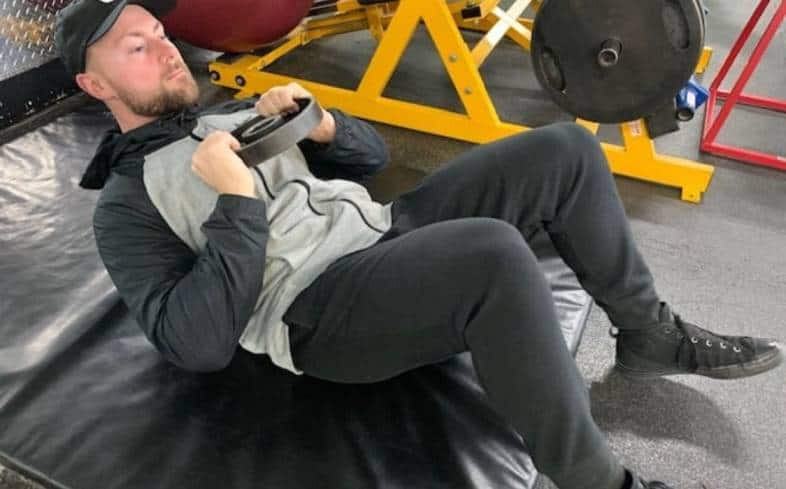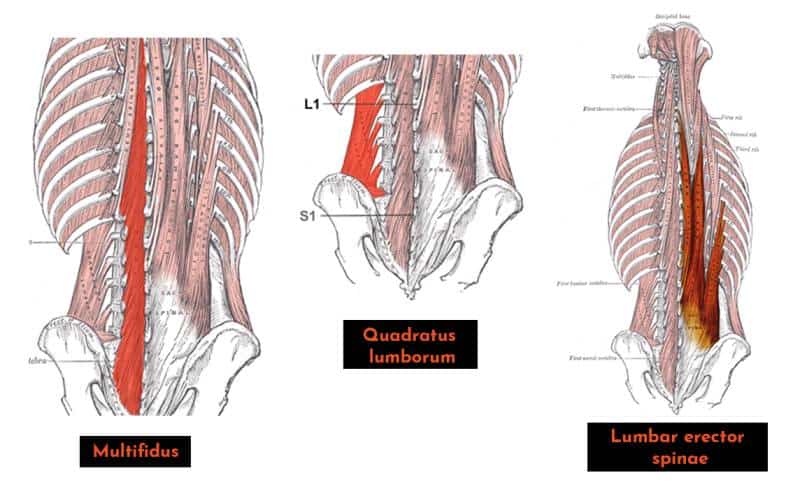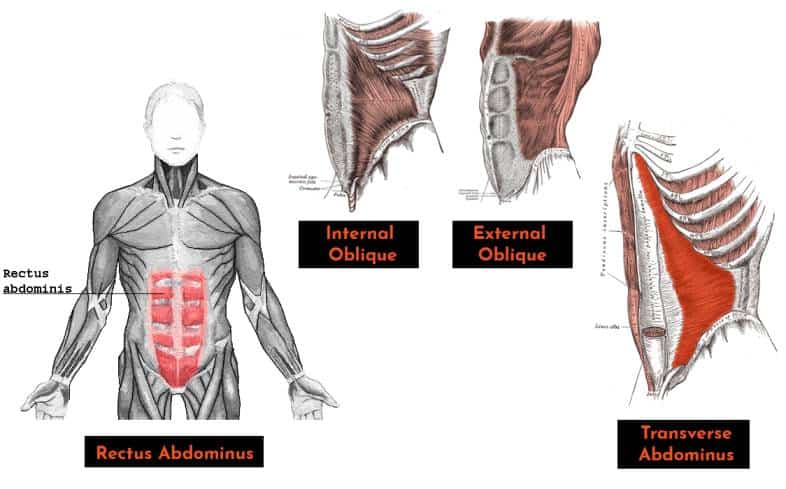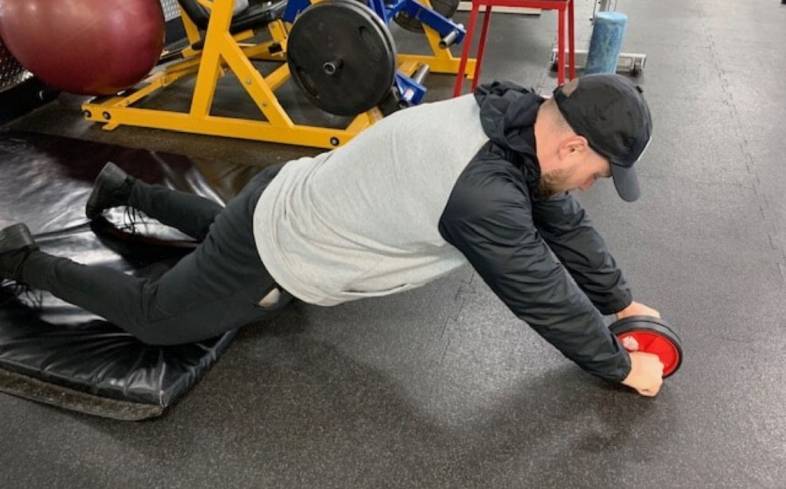The 9 Best Ab Exercises For Powerlifters (Don't Skip These) | PowerliftingTechnique.com (original) (raw)
Strength athletes like powerlifters require an incredibly strong core to squat and deadlift heavy.
What is important about a strong core is not just the aesthetics of the abs (i.e. looking ripped), it’s how the abs function when stressed under load. In the absence of a strong core, powerlifters are more susceptible to injury, have issues with their technique, and fail to transfer force to their muscles effectively.
So, what are the best ab exercises for powerlifters? Here are the top 9 ab exercises every powerlifter should do:
- Weighted Plank
- Front Plank With Single Arm Row
- Weighted Side Plank
- Copenhagen Plank
- Single-Leg Glute Bridge
- Split Stance Pallof Press
- Banded Dead Bug
- Flying Bird Dog
- Ab Rollout
As the Head Coach for Team Canada Powerlifting, these are the exact exercises that I program for my athletes in order for them to stay healthy and increase their strength on their barbell movements. In this article, I’ll discuss these exercises in more detail and explain why it’s important for powerlifters to train abs.
Why Is It Important For Powerlifters To Train Abs? (5 Reasons)

There are some powerlifting coaches who believe that just the act of squatting and deadlifting heavy will be enough ‘core work’ for any powerlifter.
Don’t get me wrong, there is a lot of stress on your core while squatting and deadlifting. As such, your abs will most certainly adapt and get stronger by doing these exercises.
However, to say that only squatting and deadlifting is required to get a strong core is a bit extreme.
It’s also naive.
Squatting and deadlifting has been shown to target the following core muscles very effectively:
- Multifidus
- Quadratus lumborum
- Lumbar erector spinae

These are the deep core muscles that are located in your back and surround your spine.
They have a role in various ‘bending’ activities where your torso moves either more or less horizontal to the floor.
This is an important function when it comes to heavy powerlifting; however, these are not the only core muscles that need to be strong to lift effectively.
We also need to focus on other core muscle groups, such as the:
- Rectus Abdominus
- Internal / External Obliques
- Transverse Abdominus

These muscles contribute to a greater amount of ‘bending’, ‘twisting’, and ‘flexing’ activities of the spine, torso, and pelvis.
If you ignore direct ab work, then you will fail to activate these additional core muscles that have a large role in how our bodies move.
If you're wondering what the role of isolation exercises play in a powerlifting training program, check out my article on Do Powerlifters Do Isolation Exercises?
Here are the 5 reasons why direct ab work, and working each part of the core, is important for powerlifters:
1. Create a Strong Brace
When we squat and deadlift heavy, one of the first things we need to do in our set up is to ‘breathe’ and ‘brace’ our core.
This ‘breathe’ and ‘brace’ technique is so important that I actually wrote two articles explaining how to do it properly: How To Breathe Properly In The Squat and How To Breathe Properly In The Deadlift.
Bracing your core effectively is the process of flexing every part of your core from your front, side, and back. It has been shown to take hundreds of pounds of pressure off your spine while lifting.
If you want to take advantage of having a strong brace, you must have a strong core to begin with, which means training your ab muscles.
Having a strong brace can prevent tailbone pain when squatting.
2. Increase Postural Control
One of the main functions of your abs is to increase postural control.
Postural control is the ability to maintain your balance.
This is particularly important while lifting because obviously you don’t want to be falling over when you have a heavy weight on your back.
Let’s say you are in the bottom of a squat, and rather than keeping the load over your center of mass, you’re constantly shifting your weight back and forth in order to maintain your balance.
As you drive up, you’re trying to give your muscles ‘gas’ to accelerate upward. However, by swaying back and forth it’s like stepping on the breaks because you’re trying to slow down to prevent yourself from falling over.
If you want to prevent your body from losing its balance, it means training your ab muscles.
Training abs should be implemented as part of your GPP Workouts – check out my article that explains this concept in more detail.
3. Prevent Inefficient Bar Path
Your abs have an important role in ensuring an efficient bar path for each exercise.
Each exercise will have an optimal bar path as it will reduce the amount of work the lifter needs to output, in addition to reducing the stress on certain joints.
For example, I wrote an entire article on the Best Bar Path For Squats and the Best Bar Path For Deadlifts, which for most people is going to be a straight line from start to finish.
Any movement off this vertical bar path leads to a much harder execution of the lift, and can increase the risk of injury (if drastic).
Therefore, it’s important that we prevent an inefficient bar bath, which means training your ab muscles.
4. Minimize Muscular Imbalances
Muscular imbalances can lead to poor technique and increased risk of injury.
A muscular imbalance is when one muscle group is more or less strong than another.
When there is a muscular imbalance, we see the body implement what’s called ‘compensation strategies’. These compensation strategies are shifts in your technique that symbolize a sign that the body has a weak point within the chain of movement.
For example, in the squat, the pelvis should remain fairly neutral as it drops into the bottom of the squat. However, sometimes we see the pelvis tuck under, which looks like the low back rounding.
This is a compensation strategy.
While the pelvis tucking could be caused by several reasons (tough to diagnose without running the lifter through a variety of tests), one reason may be because the lifter has weak lower abs compared with the rest of their core.
This is a prime example of how direct ab work can help minimize muscular imbalances, and keep the lifter moving with strong technique.
If you are someone who is powerlifting with scoliosis, you will need more direct ab work than everyone else (click to read my full guide).
5. Transfer Force Effectively
One of the main responsibilities of your abs is to transfer force effectively from the lower body to upper body and vice versa.
When you have a weak core, there will be ‘energy leakage’ as you apply force to the barbell. This is because the powerlifting movements are ‘full body’ movements, which require muscular coordination between several muscle groups at the same time.
In order to maximize your force transfer between muscle groups, you will need to ensure each aspect of your core is functioning effectively. This is why you need to implement direct ab work as a powerlifter.
You might be interested in reading my articles on Do Deadlifts Work The Core? And, Do Squats Work The Core?
Top 9 Ab Exercises Every Powerlifter Should Do

Now that we know why training abs for powerlifting is important, let’s now put that knowledge into practice. The following 9 ab exercises should be a staple among any powerlifter’s routine.
1. Weighted Plank
Weighted planks are one of my favorite core exercises to do in the gym.
This is because there are multiple ways that you can progress this movement: you can either add more weight, hold the plank for longer, or both.
With that said, I probably wouldn’t go beyond 1-minute holds, mostly because your goal is not strength endurance as a powerlifter, but rather maximal strength.
The key part of the weighted plank is to hold your brace throughout the entire set. The aim is not to ‘stay relaxed’, but to brace maximally through the entire front of your abs. In addition, you’ll want to squeeze your glutes tight. Remember to maintain proper plank form while performing this exercise.
Set Up
- Perform on your elbows or hands
- Ensure your torso is rigid from your shoulders to feet
- Keep your hips up, don’t let them sink down
- Place a plate on the mid-back (not low back)
- Think about pulling your belly button up to your spine as you’re holding the plank
- The upper back can be slightly rounded
- Flex your glutes tight to keep your pelvis neutral
2. Front Plank With Single Arm Row
The front plank with a single-arm row will challenge your ability to keep your torso neutral.
As you row the band toward your body, your torso will want to rotate side-to-side, and the core muscles responsible for twisting will need to stabilize in a static position.
This is a great unilateral movement that will work out any rotational imbalances between the right and left sides.
This exercise should be done using a slow and controlled tempo. Rather than holding the plank for time, you will be doing 10-15 reps per arm.
Set Up
- Set up a band or cable low to the ground attached to a fixed object about 3-4 feet in front of your head
- Perform plank on your elbows and grab the band with one arm
- Row the band so that your elbow drops down to your side
- Hold for 1-sec at the bottom position before returning your arm overhead
- Keep your hips neutral to the ground avoiding any twisting
Related Article: How To Do A Sit Up Without Lifting Your Feet? (5 Tips)
3. Weighted Side Plank
The weighted side plank is another great exercise for working out imbalances between the right and left sides.
In addition to developing core strength through the internal/external obliques, you will also benefit from the additional shoulder stability.
If you’ve never done a side plank before, you will want to start with a bodyweight side plank first. This is because it doesn’t take much for you to become very sore from doing this exercise.
The key part about the weighted side plank is to resist the torso from dropping toward the floor.
You can start with 15-30 seconds per side, and use the same weight to build up to 45-60-seconds per side. At that point, you should increase the weight.
Set Up
- Place your elbow directly underneath of your shoulder
- Bring your hips off the ground so that your torso is rigid from shoulders to feet
- Your hips and torso should be neutral avoiding twisting forward or back
- Place a dumbbell in the hand that is not on the ground
- Lift that arm straight over your shoulder
- Hold this position for the prescribed time
4. Copenhagen Plank
The Copenhagen plank is a lesser-known variation of the side plank that also works the inner and outer thigh muscles.
It’s an important exercise for sumo deadlifters because it will keep your adductors healthy while pulling in a wide stance. Having strong adductors will help in hip extension and rotational power.
You will hold the copenhagen plank for time, typically starting at 15-30 seconds per side and increasing it over time.
There are several variations of the Copenhagen plank to make it easier or harder depending on your skill level.
Set Up
- Begin in a side-lying position and place your top leg on a bench.
- Easier variation: Bend the top leg
- Harder variation: Keep the top leg straight with just your ankle on the bench
- Contract your inner groin muscle and press your top leg into the bench
- The bottom leg should be off the ground either tucked with the knee toward the chest or straight
- Keep the shoulders stacked over the elbow and hips stacked over each other
Related Article: Are Planks Better on Elbows or Hands? (Pros & Cons)
5. Single-Leg Glute Bridge
The glute bridge is typically an exercise prescribed to strengthen the glute max.
However, it will also require strong low ab muscles to stabilize the pelvis position, in addition to deep core muscles within the low back.
Furthermore, with stronger glutes, your hips won’t be as tight, which will offset how hard your abs need to work under load.
This is another single-sided variation to ensure that you’re working any imbalances between the right and left sides of the body.
Hold the glute bridge for 15-30 seconds and aim to progress it over time.
Set Up
- Place your upper back on a bench
- Place your feet underneath of your knees with your legs bent at 90-degrees
- Tuck your chin and lift your hips so your torso is parallel to the floor
- Lift one leg from the ground and place it straight so that it’s also parallel to the floor
- Hold this position for the prescribed time before switching
- Ensure your hips don’t shift side to side when your leg lifts from the floor
Related Article: I Can't Do A Sit Up: 7 Reasons & How To Fix
6. Split Stance Pallof Press
The pallof press is an isometric core exercise that places tension on your obliques and deep spinal muscles as you move a weight from the cable stack through a range of motion.
You can do the pallof press with both feet on the same plane, but the split stance variation is the more advanced variation. If you don’t have a cable to do this exercise, you can use a band.
It’s core exercises like this that help prevent you from twisting side to side in the squat and deadlift.
Perform 15-20 reps per side ensuring your posture doesn’t change throughout the entire movement.
Set Up
- Attach a handle to a cable system at shoulder height
- Place your feet in a split stance with the feet shoulder-width apart
- Hold the handle to your chest and press it horizontally (away from you)
- Your arms should travel parallel to the floor
- Return to the starting position ensure the cable stack is not lowering
7. Banded Dead Bug
The dead bug exercise is performed laying on your back, which works your rectus and transverse abdominus.
These are the muscles that help you flex your spine and stabilize your pelvis under load.
The dead bug is commonly prescribed for people with chronic low back pain or people who have suffered a back injury.
It’s also another exercise that is ‘single-sided’, which means you’ll be working the right and left side independently.
There is also some degree of coordination required to execute this movement effectively, which will improve motor control and awareness.
While the dead bug can be performed with just your bodyweight, the banded variation is the more advanced progression, which reinforces the importance of keeping your core tight throughout the entire movement.
Perform 8-15 reps per side, making sure you don’t break contact with your low back from the floor as you fatigue.
Set Up
- Lie on your back on the floor
- Bring your feet off the ground and tuck your knees toward your chest
- Your knees should be at a 90-degree angle
- Bring your arms straight up over your shoulder and hold a band that is attached behind your head
- Push your low back into the floor by drawing your rib cage down
- Start by bringing your right leg to the floor
- As you do this, don’t break contact with your low back from the ground
- Return your leg to the start position and switch sides
8. Flying Bird Dog
The flying bird dog encourages a neutral spine position while at the same time working the muscles in your low abs and low back.
It will also strengthen your hips and promote proper posture. It is typically used as a warm-up exercise for the squat and deadlift to ensure your deep core muscles are activated prior to loading the body.
If you’re doing this movement properly, it should feel quite exhausting trying to keep your hips and spine neutral.
Perform 8-15 reps per side with a slow and controlled tempo.
Set Up
- Begin on all fours (hands and knees)
- Place your knees under your hips and your hands under your shoulders
- Keep your spine neutral by slightly flexing your abs and keeping your shoulder blades retracted
- At the same time, lift your right leg and left leg off the floor and bring them parallel to the floor
- Pause for 1-2 seconds in this position before returning to the start position
- The hands and legs must leave and return the floor at the same time
- Avoid any twisting of the hips or torso through the execution of the exercise
Related Article: 11 Best Cable Crunch Alternatives (With Pictures)
9. Ab Rollout
The ab rollout is a great total core exercise that works the rectus, obliques, erectors, in addition to the shoulders, lats, and upper back.
The ab rollout is similar to a plank, but rather than having your hands and arms underneath of your shoulders, they are moving above your head.
As such, you can consider this a more advanced version of the plank. Before you start doing the ab rollout, you should be able to do a front plank for at least 60-seconds.
The key part about the ab rollout is not letting your hips sink as you perform the movement. If you fail to keep your hips and torso neutral through this movement it might feel slightly uncomfortable on your low back.
To perform the ab rollout, you’ll need either an ab wheel or swiss ball. Perform 10-15 reps, or as many reps as possible while holding strict form.
Set Up
- Kneel on the floor with a stability ball in front of you
- Place your hands and forearms on the ball making sure your elbows are bent at 90-degrees
- Keep your body in a straight line from your head to hips
- Roll the ball forward with your arms, keeping a slow and controlled tempo
- Extend as far as you can while not letting your hips sink
- Your chest can touch the ball, but don’t rest on the ball
- Slowly reverse the movement by bringing your elbows back to the start position
Another great core exercise that also works your pressing muscles is the Z Press. Check out my other guide that covers this exercise in greater detail.
Final Thoughts
You shouldn't think just because you squat and deadlift heavy that your abs are getting the work they need to keep your body healthy in the long run. You'll want to implement direct ab work in order to work the core muscles that aren't trained in the primary movements.